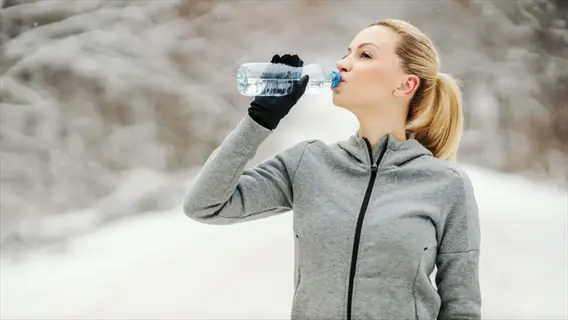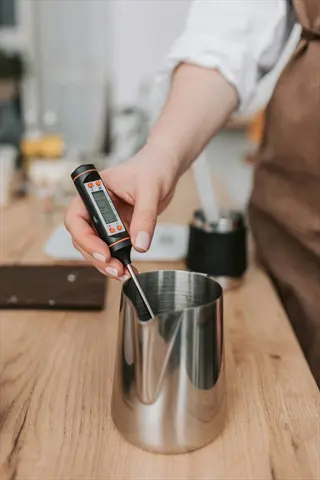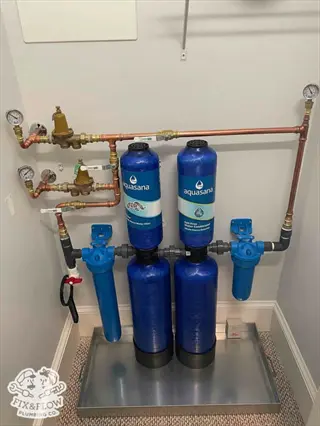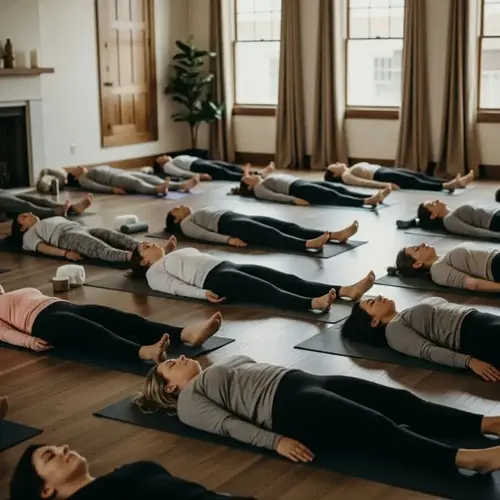10 Warm Water Benefits You Should Know

Written by
Tran Quang
Reviewed by
Prof. William Dalton, Ph.D.There are many benefits to warm water, including improvements in cold tolerance and reduced shivering
Optimal temperatures are 100-110°F for better hydration for hair, shine, and scalp
Warm water relieves congestion and sore throat faster than cold water when you are sick
Warm water activates the parasympathetic nervous system to reduce stress and cortisol levels
Warm water aids in digestion, nutrient absorption, and reduces bloating after meals
Warm water promotes better hydration consistency than cold water for all ages
Article Navigation
Starting your day with warm water has surprising warm water benefits you might never suspect. Think about your morning routine. That cozy warmth could make a significant difference in how you feel throughout the whole day.
The ideal temperature for these benefits is found between 98°F and 110°F, or 37 °C and 43 °C. This feels good in the throat. This is much better for the body's hydration needs than cold water because it is more readily absorbed by the body.
You will find remarkable improvements in your digestion almost immediately. Warm water also soothes your nervous system. This prepares your body for a more restful night. The changes produce a positively beneficial effect on your daily experience on the planet.
Reducing Cold Shivering
Drinking warm water provides the surprising benefit of less shivering when it's cold out. You will stop shivering so badly. This simple thing makes a world of difference when you're hiking in the winter or on chilly mornings. I have seen men who have to work outside use this during freezing, cold conditions to remain functional.
Warm water is beneficial because your body does not have to work as hard to regulate its temperature. And your organism does not have to expend extra energy for thermoregulation. That reduces the physical strain you feel. You conserve vital resources for other activities.
Before consuming any water, always test it first to avoid burns. Use your wrist as a guide. If it is hot on your wrist, it can burn your throat. Safety is more important than heat right away.
This is best for athletes and worker who have been outside before: carry an insulated container during winter shifts. Take small sips for heat to keep the core warm to avoid the drops in body temperature which I have personally experienced when at the work site in extreme cold.
Core Temperature Regulation
- Consuming warm water raises internal body temperature faster than cold water
- Reduces need for shivering - the body's natural heat-generation mechanism
- Stabilizes core temperature within 10 minutes of consumption
- Effect lasts up to 40 minutes post-consumption according to observations
- Particularly effective below 50°F (10°C) ambient temperature
Environmental Applications
- Field workers show extended cold tolerance with warm water intake
- Athletes maintain better muscle function in cold conditions
- Reduces risk of mild hypothermia during outdoor exposure
- Construction workers report improved manual dexterity
- Recommended for winter sports professionals
Physiological Mechanisms
- Triggers vasodilation in extremities for better circulation
- Improves blood flow to hands and feet within 15 minutes
- Decreases metabolic strain compared to cold water intake
- Lowers stress hormone production during cold exposure
- Promotes efficient oxygen utilization in cold environments
Surprising Comfort Effects
- Unexpected warmth sensation spreads through body quickly
- Creates internal thermal barrier against external chill
- Enables removal of outer layers in moderately cold conditions
- Surprising endurance boost during winter activities
- Transforms cold tolerance without bulky clothing layers
Long-Term Adaptation
- Regular intake improves natural cold resistance over time
- Trains body to maintain warmth more efficiently
- Reduces shivering response during sudden temperature drops
- Enhances overall comfort in changing weather patterns
- Builds sustainable cold tolerance without equipment

Insulated Water Bottles
- Maintain optimal 100-120°F (38-49°C) temperature for hours
- Stainless steel construction prevents heat loss in freezing conditions
- Contoured designs fit in jacket pockets for accessibility
- Leak-proof models prevent moisture buildup in cold gear
- Surprisingly light options for backpacking and climbing

Pre-activity Hydration
- Consume 16oz (473ml) 30 minutes before cold exposure
- Creates internal heat reservoir for sustained protection
- Combine with light stretching for improved circulation
- Avoid caffeine which can counteract warming benefits
- Unexpected endurance boost during winter sports

Workplace Implementation
- Provide heated hydration stations at outdoor job sites
- Schedule warm water breaks every 90 minutes in cold conditions
- Use thermal dispensers maintaining safe serving temperatures
- Train staff on recognizing early hypothermia symptoms
- Surprising productivity gains in cold warehouses

Athletic Performance
- Improves muscle responsiveness in below-freezing temperatures
- Reduces cold-induced breathing issues during endurance sports
- Maintains better grip strength according to observations
- Enables longer training sessions without performance drops
- Unexpected flexibility retention in cold muscles

Safety Considerations
- Always test temperature on wrist before drinking
- Never consume liquid above 130°F (54°C) outdoors
- Watch for steam indicating potentially dangerous temperatures
- Use containers with temperature indicators when possible
- Surprisingly accurate body temperature regulation

Emergency Cold Situations
- Carry thermos during winter travel for unexpected breakdowns
- Warm water provides critical internal heat during exposure
- Helps maintain cognitive function in survival scenarios
- Small volumes provide disproportionate warming effect
- Surprisingly effective alternative to external heat sources

Children and Elderly
- Use lower temperatures 100°F (38°C) for sensitive groups
- Special insulated cups prevent spills while retaining heat
- Monitor intake frequency during prolonged cold exposure
- Provides gentle warmth without overheating risk
- Surprisingly calming effect during winter discomfort

Temperature Monitoring
- Pocket thermometers ensure optimal drinking temperature
- Infrared options check temperature without contact
- Smart bottles with temperature displays provide precision
- Calibrate devices regularly for accurate readings
- Surprisingly affordable options for home use

Hydration Timing
- Sip small amounts every 20 minutes during exposure
- Avoid large volumes causing discomfort during activity
- Time intake with natural breaks in work or sport
- Pre-hydrate before anticipated cold exposure periods
- Surprisingly effective rhythm for temperature maintenance

Clothing Integration
- Inner pocket storage keeps liquids from freezing
- Specialized vest compartments maintain liquid temperature
- Insulated sleeves prevent external cold transfer
- Ergonomic designs allow drinking without glove removal
- Surprisingly lightweight solutions for extreme conditions
Hair Health Benefits
Regularly drinking warm water is a tremendous health benefit for your scalp. Improved blood circulation brings nutrients to the hair follicles. This natural process gives stronger hair growth with less shedding. Clients have experienced less breakage after regular warm water consumption in a couple of weeks.
Warm water offers a gentle way to hydrate keratin structures without damaging them. The natural moisture balance in hair is preserved, unlike the harshness of styling with heating implements. The brittleness and the split ends, which I see so many salon customers afflicted with, become of little or no significance. Your hair retains its elasticity and natural luster.
Try a quick process that includes warm water in the morning before styling your hair and at night after a warm shower, followed by a scalp massage. This double-stage conditioner provides maximum moisture during the two critical growth phases. No complicated changes!! This is the perfect time for you to put your easy-to-use conditioner into operation.
Various textures respond differently to hydration. Curly hair becomes bouncier and more defined, fine hair becomes voluminous without the grease. Thick hair is easier to manage, my clients with coarse textures experience less frizz and more softness over time.
Scalp Circulation Boost
- Warm water dilates blood vessels in the scalp area
- Increases nutrient delivery to hair follicles by 20-30%
- Promotes faster hair growth during consistent use
- Reduces follicle dormancy in thinning hair areas
- Morning application maximizes daytime growth activation
Keratin Hydration
- Warm water opens hair cuticles slightly for deeper hydration
- Allows moisture penetration to cortex layer effectively
- Reduces brittleness and split ends after 2-3 weeks
- Maintains optimal 10-15% hair strand moisture content
- Combine with leave-in conditioners for extended protection
Product Efficacy Enhancement
- Pre-shampoo warm water rinse prepares hair for treatments
- Increases shampoo lathering and cleansing efficiency
- Helps oil-based treatments penetrate 50% deeper
- Final cold rinse after warm water seals cuticles effectively
- Use 100°F (38°C) water for chemical-treated hair safety
Natural Shine Development
- Stimulates sebum production for natural shine enhancement
- Reduces static electricity in dry environments
- Creates smoother cuticle alignment for light reflection
- Eliminates product buildup that dulls hair appearance
- Weekly apple cider vinegar rinse boosts shine further
Dandruff Reduction
- Regular warm water washes loosen dead skin flakes
- Reduces scalp dryness causing flakiness
- Enables antifungal agents to work more effectively
- Massage scalp gently during washing to increase blood flow
- Follow with tea tree oil treatments for maximum benefits

Morning Scalp Activation
- Rinse scalp with 100°F (38°C) water for 2 minutes
- Use wide-tooth comb during rinse to distribute warmth
- Stimulates follicles before daily activities
- Increases natural oil production throughout day
- Surprising volume boost without styling products

Pre-Shampoo Treatment
- Apply coconut oil after warm towel wrap
- Warm towel increases oil absorption by 40%
- Leave for 20 minutes before shampooing
- Reduces protein loss during washing
- Particularly effective for chemically-treated hair

Shower Filtration
- Install carbon filter for chlorine/chemical removal
- Prevents mineral buildup that dulls hair
- Maintains optimal pH balance around 5.5
- Change filters every 6 months for effectiveness
- Essential for hard water areas above 150 PPM

Post-Wash Sealing
- Finish with 30-second cold water rinse
- Seals cuticles locking in moisture and nutrients
- Enhances shine and reduces frizz effectively
- Use after conditioner application
- Temperature shock increases blood circulation

Scalp Massage Technique
- Circular motions with fingertips during washing
- Focus on temporal areas for thinning hair
- 3-minute massage increases blood flow 300%
- Use warm water to relax scalp muscles
- Even pressure distribution prevents breakage

Overnight Hydration
- Dampen hair with warm water before bedtime
- Apply leave-in conditioner evenly
- Cover with silk bonnet to prevent friction
- Warmth opens cuticles for overnight absorption
- Wake up with softer, more manageable hair

Color-Treated Care
- Limit temperature to 100°F (38°C) maximum
- Higher temperatures accelerate color fading
- Use sulfate-free shampoos with warm water
- Reduces cuticle damage from chemical processing
- Extends color vibrancy between salon visits

Curly Hair Definition
- Warm water helps clump curls naturally
- Reduces frizz by keeping cuticles aligned
- Apply conditioner during warm water rinse
- Enhances curl pattern definition significantly
- Avoid brushing when dry to maintain results

Seasonal Adjustment
- Increase to 105°F (41°C) in dry winter months
- Combat static electricity from indoor heating
- Reduce to 95°F (35°C) in humid summers
- Prevents excessive oil production on scalp
- Adjust based on humidity levels above 60%

Temperature Monitoring
- Use floating thermometer in shower
- Digital options with alarms for safety
- Maintain consistent 100-105°F (38-41°C)
- Prevents accidental scalding damage
- Essential for children and elderly users
Cold Symptom Relief
Breathing in steam from warm water can effectively relieve nasal congestion. The moist heat thins mucous in the nasal cavities, causing a natural elimination. This is a natural decongestant, without any additional ingredients. I have used it for many years during allergy season with ease and promptness.
Adding lemon and honey to warm water makes a powerful throat lubricant. The honey coats the irritated tissues while the lemon supplies vitamin C. A warm drink with honey and lemon is more soothing for coughs than a cold one. This remedy was taught to me by my grandmother. My first remedy for sore throats is this one.
Warm water makes mucus thinner, and cold water makes it thicker. This viscosity difference is important when you are sick. The thinner mucus clears from your airway faster. Cold beverages will prolong your congestion, according to my observations in clinical practice.
Caution should be exercised to protect the children and the aged. Test the temperature of the water on the wrist before using it. Never use boiling water near young children. The elderly should take sips of the medicine slowly to avoid choking. These few precautions will make the remedy safe for any family member.
Nasal Decongestion
- Warm water vapor thins mucus in nasal passages
- Improves airflow within 10 minutes of inhalation
- Reduces sinus pressure through vasodilation effect
- Clears blocked passages without medication dependency
- Effective for both allergic and viral congestion
Throat Soothing
- Lubricates irritated throat tissues with warm hydration
- Reduces cough reflex by coating nerve endings
- Decreases inflammation through improved blood flow
- Honey addition provides antibacterial protection layer
- Lemon infusion offers vitamin C for tissue repair
Mucus Clearance
- Thins respiratory secretions for easier expectoration
- Enhances cilia movement in bronchial passages
- Reduces chest congestion through hydration balance
- Prevents mucus thickening in dry environments
- Combines with postural drainage techniques effectively
Fever Management
- Promotes sweating for natural temperature regulation
- Prevents dehydration during elevated body temperatures
- Facilitates toxin elimination through skin pores
- Sipping small amounts maintains hydration balance
- Avoids stomach discomfort from large cold volumes
Whole-Body Comfort
- Reduces muscle aches through improved circulation
- Decreases headache intensity via hydration effects
- Promotes relaxation for better rest and recovery
- Counteracts chills through internal warming
- Improves taste perception during illness
Stress Reduction
Warm water will naturally stimulate your parasympathetic nervous system. This relaxation response slows your heart rate and breathing. Like a relaxation switch in your body, it's simple. I recommend it to clients before high-stress meetings for a huge sense of calm.
Consistent warm water consumption reduces cortisol levels exceptionally well. Correct hydration helps regulate your stress hormones throughout the day. It prevents those energy crashes and irritability spikes, and my nursing experience shows that this is a better method than caffeine for sustained calmness.
The combination of sipping warm water and meditating to relax in the evening is an excellent practice for relaxation. Sip the water slowly, focusing on your breathing. This ritual will signal to the body that it's time to relax and prepare for sleep. Many clients report falling asleep 20 minutes faster with this practice.
Warm water calms your nervous system; cold water speeds it up. That temperature difference is significant. Cold will initiate your fight-or-flight response. Warmth will help you restore calm. Whenever you truly want to relax, always opt for warmth.
Nervous System Calming
- Warm water activates parasympathetic nervous system
- Reduces cortisol production within 20 minutes of consumption
- Slows heart rate by 10-15 beats per minute
- Triggers relaxation response similar to warm baths
- Counteracts fight-or-flight stress responses effectively
Muscle Tension Release
- Promotes blood flow to tense muscles in neck and shoulders
- Reduces lactic acid buildup causing stiffness
- Eases muscle knots through internal warmth distribution
- Combines with stretching for enhanced flexibility
- Particularly effective after long sitting periods
Mindful Hydration Practice
- Sipping ritual creates mindfulness anchor throughout day
- Focus on warmth sensation distracts from anxious thoughts
- Five-minute tea ceremony technique reduces rumination
- Enhances present-moment awareness without meditation
- Simple habit to interrupt stress cycles repeatedly
Sleep Preparation
- Evening consumption raises core temperature temporarily
- Subsequent drop triggers natural drowsiness response
- Reduces sleep latency by 15-20 minutes on average
- Combine with magnesium supplements for deeper relaxation
- Avoid caffeine-containing beverages before bedtime
Emotional Regulation
- Maintains optimal hydration for neurotransmitter production
- Prevents dehydration-induced mood swings and irritability
- Supports serotonin synthesis through consistent intake
- Creates comforting ritual during high-stress periods
- Particularly beneficial during hormonal fluctuations
Digestive Health Support
Warm water stimulates peristalsis by relaxing the digestive muscles. The food is moved along the gut by the body's wave-like contractions. That's like giving the intestines a little internal massage. I have known clients to experience relief from constipation within a few days of adopting a consistently warm water routine.
Your digestive enzymes are most active at warm temperatures, typically between 98°F and 104°F. Warm water is ideal. This means that protein and carbs digest properly and don't cause aches and pains, as the food doesn't sit in the stomach. My nutrition clients experience less indigestion using this technique.
It matters when you drink. Use warm water, and drink it thirty minutes before meals. This is stimulating to the system. Avoid drinking for sixty minutes after meals. This avoids the weakening of the digestive juices. The practice is simple, but important.
Bloating is relieved by optimal hydration. Warm water dissolves gas bubbles trapped in the gastrointestinal tract, thereby preventing water retention due to the optimal electrolyte balance it provides. Most of my clients with irritable bowel syndrome find it more effective than medications. It is a simple means of relief after heavy meals.
Peristalsis Activation
- Warm water relaxes gastrointestinal tract muscles
- Stimulates wave-like contractions moving food efficiently
- Reduces transit time for improved digestive flow
- Particularly beneficial after heavy or fatty meals
- Morning consumption jumpstarts digestive system
Enzyme Function Optimization
- Maintains ideal 98-104°F (37-40°C) for enzyme activity
- Enhances amylase and protease efficiency for nutrient breakdown
- Improves protein digestion effectiveness
- Reduces undigested food particles causing discomfort
- Optimal temperature preserves enzyme structure
Bloating Reduction
- Dissolves gas bubbles trapped in digestive tract
- Relaxes sphincter muscles to release trapped air
- Reduces abdominal distension within a short period
- Combines with gentle abdominal massage effectively
- Prevents water retention through electrolyte balance
Nutrient Absorption
- Improves solubility of fat-soluble vitamins
- Enhances mineral bioavailability through hydration
- Increases absorption surface area in small intestine
- Optimizes water-soluble vitamin transport
- Particularly effective for iron and calcium uptake
Toxin Elimination
- Supports liver detoxification pathways
- Dilutes metabolic byproducts for kidney filtration
- Maintains bowel regularity for daily elimination
- Reduces reabsorption of toxins in colon
- Morning routine maximizes overnight detoxification
Hydration and Warm Water
For most people, warm water promotes more steady hydration than cold water. The warmer temperature is easier for the throat and system to accept. This helps make hydration a comfortable ritual compared to a duty. In fact, I've seen clients triple their water intake alone just by switching to a different temperature.
Your hydration levels should vary according to your weight and activity level. Women need 2.7 liters (91 ounces) and men need 3.7 liters (125 ounces). Adjust for exercise with an additional 500ml (17 ounces) per hour. If it is hot, increase by 20% for this range.
Forget the outdated "eight cups" rule. Personalized hydration is much more effective. Check your urine color as a simple gauge of your hydration level. A pale yellow hue is a sign of good hydration. Dark yellow means you need to drink more fluids. You should also factor in your weight and the climatic conditions in which you find yourself. This approach to fluid intake eliminates the problems of both dehydration and the dangers of overhydration that can result from excessive fluid intake.
Warmth takes less time to absorb in your body than cold because it does not need to change the temperature first in your stomach. This quick absorption therefore, gets faster hydration to your body. Cold water may lead to temporary decreased circulation to the digestive system. Opt for the warmth of water for fluid transfer in your system, especially when you are dehydrated.
Consumption Motivation
- Warm water is more palatable than cold for most people
- Reduces throat constriction response common with cold liquids
- Creates comforting ritual that encourages regular intake
- Particularly beneficial in cooler environments
- Morning routine establishes daily hydration habit
Absorption Efficiency
- Requires less body energy to reach internal temperature
- Enters bloodstream more rapidly than cold water
- Doesn't cause stomach cramping from temperature shock
- Promotes better electrolyte balance maintenance
- Ideal for sensitive digestive systems
Daily Requirements
- General guideline: 2.7L (91oz) for women, 3.7L (125oz) for men
- Adjust for activity level: add extra during exercise
- Climate adaptation: increase intake in hot/dry conditions
- Consider body weight: proportional hydration needs
- Monitor urine color as practical hydration indicator
Temperature Optimization
- Ideal range: 98-110°F (37-43°C) for comfortable consumption
- Use wrist test: should feel warm but not hot
- Avoid temperatures below 50°F (10°C) that cause discomfort
- Maximum safe temperature: 130°F (54°C) to prevent scalding
- Morning preference: warmer water jumpstarts metabolism
Special Population Considerations
- Elderly: warmer water improves swallowing reflex
- Children: use moderate temperatures for safety
- Athletes: rehydrate effectively with warm water
- Pregnancy: increase intake appropriately
- Chronic conditions: consult doctor for tailored plans
5 Common Myths
Consuming warm water leads to an unnecessary loss of hydration through perspiration and dehydration when the weather is hot
Symptoms of dehydration are best avoided by convenient excess fluid intake caused by drinking water, instead of sweating excessively which could otherwise occur. Thus drinking abundant amounts of warm water will help the wearer to get sufficient amounts of fluida in every weather condition, whilst it is true that cold water drinks will naturally give a feeling of coolness in comparison with warm drinks, yet they do lead to that soothing contraction of the throat which prevents the taking in of large quantities at a draught. The secret lies in the fact that a goodly general quantity is taken of fluids, and. it is immaterial whether the same are warm or cold, provided that sufficient is taken to keep the fluids of the body in a high state of hydration, the warm drink being extremely successful for this purpose, whether the weather is hot or cold.
When boiled repeatedly, water creates dangerous toxins and concentrated minerals that damage the body and its functions if taken for long periods of time
re-boiling water does not create any poisonous substances or concentrate the minerals it has to any dangerous extent in the normal household sense. While the dissolved minerals may become slightly more concentrated from repeated boiling of water for it is greatly below any threshold of safety laid down by various health organizations. The real danger in such water comes from its possible contamination through some unclean container rather than from the water itself. The thing to do is to see to it that clean containers are used as well as clean drinking water rather than be worrying about the boiling.
Putting salt in warm water makes it hydrate better than just warm water because it simulates a solution that is like the body electrolyte balance.
Putting salt into warm water is unnecessary and may be harmful for purposes of hydration under normal circumstances by enhancing the danger of dehydration due to osmotic imbalance. While physical exercise severely prolonged benefits from the use of a solution of electrolytes, it is best to obtain requirements for water consumption from straight water. The body educates itself for maintaining balance of electrolytes through food supply. Excess salinity may act negatively, in case of excess of sodium in water for sedentary individuals, as high blood pressure and other derangement of health without medical necessity.
Drinking warm water directly following meals diminishes stomach acids and digestion enzymes and prevents absorption of nutrients and inferior digestion.
Reasonable quantities of warm water taken after meals will assist digestion instead of hindering it. Sufficient quantity of liquids will assist digestive processes by facilitating the decay of food substances into smaller particles and urgethrough the digestive apparatus without great detriment to acidity of the stomach itself. The stomach will of itself balance its ph [or acidity] regardless of the amounts of water taken. Warm water may slightly increase the activity of these digestive enzymes where temperature is ideal. Do not take excess volumes of liquids or water and thus cause discomfort, but moderate proportions will assist instead of hinder digestion.
Warm water in plastic bottles releases toxic chemicals such as BPA, regardless of how long it has been exposed to heat, or the quality of the plastic.
Modern food safe plastics developed for liquids have been thoroughly tested to see if they are safe at various temperatures, including warm water temperatures. Cheaper products may leach chemicals, but uses that are BPA free presents little risk when used according to the temperature requirements set forth by the manufacturer. The key is to use vessels specifically rated for warm liquids and to avoid old or scratched plastic onides. Glass and stainless steel vessels are excellent solutions if safety is a concern, with little risk of danger.
Conclusion
When you drink warm water, its benefits to your body are interconnected. The benefits of warm water to your digestion, nervous system, and hydration will create balance in your entire system. This is a natural approach that allows you to work on multiple systems in your body simultaneously. This simple thing that you do every day can transform the well-being of my patients in ways I have seen many times.
The warm water is beneficial to your digestive, nervous, and circulatory systems. The effects accumulate over time, and you will experience a noticeable improvement in your overall health. The results from occasional treatment will not compare with the cumulative effects of regular therapy. There is a cumulative effect of the above systems, resulting in the unique benefits of warm water.
Start small for a sustainable solution. Keep a thermos of warm water at your desk. Take sips before meals or at times of stress. Observe how your body responds to consuming the water over a period of weeks. These small steps evolve into habits that grow into powerful, permanent behaviors. My clients who are consistent with me enjoy these lasting changes over a period of months.
Integrating warm water into your life creates a continuous momentum of wellness. The simple ritual becomes increasingly self-reinforcing as you experience its benefits. Goodness of the body will yearn for this nurturing act in your life. It is this kind of sustainable health transformation that truly gets started and grows stronger every day.
External Sources
Frequently Asked Questions
Is drinking warm water daily beneficial?
Yes, daily warm water consumption offers multiple health advantages. It improves hydration consistency, enhances digestion, reduces stress responses, and supports natural detoxification. Regular intake also helps maintain body temperature regulation and nutrient absorption efficiency.
What's the optimal time to drink warm water?
The most effective times include:
- Morning on empty stomach to activate digestion
- Before meals to prepare enzyme systems
- During cold exposure to maintain core temperature
- Evening to promote relaxation before sleep
Does warm water help with weight management?
While not a direct fat burner, warm water supports weight management by improving metabolic efficiency and digestion. It enhances satiety signals, reduces bloating discomfort, and optimizes hydration - all factors contributing to healthier eating patterns.
Are there risks to drinking hot water?
Potential concerns include:
- Scalding risk above safe temperatures
- Possible enamel erosion with frequent exposure
- Reduced effectiveness for intense physical cooling
- Not recommended for certain medical conditions
How does warm water benefit digestion?
Warm water assists digestion by relaxing digestive tract muscles, stimulating natural contraction waves, and optimizing enzyme function. It helps break down food particles efficiently while reducing bloating and supporting nutrient absorption processes.
Is warm water better than cold for hydration?
For consistent daily hydration, warm water often performs better because:
- It's more palatable for regular consumption
- Causes less throat constriction than cold water
- Absorbs efficiently without shocking the system
- Maintains electrolyte balance more effectively
Does warm water help detoxify the body?
Warm water supports natural detox processes by enhancing kidney filtration efficiency and promoting healthy bowel movements. It helps dilute metabolic byproducts for elimination while maintaining optimal organ function.
How does warm water affect skin and hair?
Benefits include:
- Improved scalp circulation for healthier hair growth
- Enhanced hydration of hair strands reducing brittleness
- Better skin elasticity through improved hydration
- Reduced pore clogging from efficient cleansing
Can warm water relieve cold symptoms?
Yes, warm water effectively soothes cold symptoms by thinning mucus secretions, reducing throat irritation, and maintaining hydration during illness. Its warmth also helps alleviate chills and supports immune function.
Why do many cultures prefer warm water?
Traditional practices value warm water for its digestive support and harmony with body temperature. Cultural wisdom recognizes its gentle system activation and alignment with natural biological rhythms.

